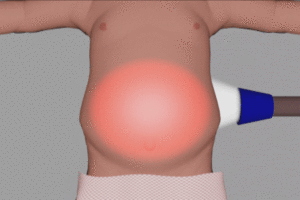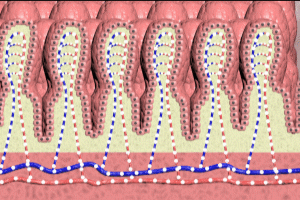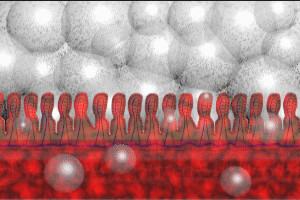Peritoneal Tap in Necrotizing Enterocolitis PED033
Peritoneal Tap in Necrotizing Enterocolitis Transcript
Peritoneal Tap in Necrotizing Enterocolitis
This is Dr. Cal Shipley with a review of peritoneal tap in the treatment of necrotizing enterocolitis.
To get the most out of this presentation, I would recommend that you first review my video on necrotizing enterocolitis in which I do an in-depth review of the pathophysiology of the disease. For the purposes of this video, I’m just going to do a quick recap of the pathophysiology of NEC.
Necrotizing Enterocolitis
In necrotizing enterocolitis, severe overgrowth of pathogenic hospital-based bacteria, as well as colonic bacteria, occurs in the small intestine. This bacterial overgrowth in turn produces large amounts of gas which distends both the small intestine and the colon. Gas-related pressure combined with inflammation result in tissue necrosis and perforation of the intestinal wall. Gas and bacteria-laden discharge leak through the perforations and into the peritoneal cavity. This view of the abdomen seen from the right side in cross-section demonstrates the presence of gas and bacteria-laden fluid within the peritoneum.
Continued gas formation can result in steadily increasing pressure within the abdominal cavity resulting in additional necrosis of small intestinal tissue as well as progressive difficulty in breathing due to gas pressure exerted against the diaphragm, while bacteria from the fluid discharge can eventually access the bloodstream resulting in septicemia, shock and death. Removal of the gas and fluid from the peritoneal cavity can help to prevent these potentially very serious complications. This is where procedures like the peritoneal tap come into play.
Procedures Used to Remove Peritoneal Gas and Fluid
There are three procedures currently in use to remove gas and fluid from the peritoneum.
Laparotomy
Surgical abdominal laparotomy is the most invasive of the three procedures and potentially the most stressful on the physiology of a sick infant.
Laparotomy involves opening of the abdomen to remove gas, fluid and necrotic areas of the intestine.
Primary Peritoneal Drainage (PPD)
Primary peritoneal drainage involves making a small incision in the abdomen and the placement of a drain into the peritoneal cavity, which is then left indwelling for up to several days.
Peritoneal Tap
And finally, the peritoneal tap procedure. Peritoneal tap is considered the least invasive of the three options and involves inserting a cannula, which is essentially a large bore needle, into the peritoneal space. The cannula may be left in place for up to a few hours until adequate fluid and gas has been removed. The cannula may be reinserted as needed to remove additional accumulations of gas and fluid.
Peritoneal Tap Procedure
Now, let’s take a look at the procedure for a peritoneal tap. Prior to the procedure, the abdominal girth of the infant is measured as a baseline.
Transillumination
The first step is to use a bright light source to transilluminate the abdomen. Because the area filled with gas is less dense than the rest of the abdominal contents, it transmits more light and appears as a bright area, as shown here. A cannula is then inserted into the peritoneum in the area of greatest brightness.
Removal of Fluid and Gas
Looking at a cross-sectional view of the abdomen from the right side, the tip of the cannula can be seen within the peritoneal space. Typically, a syringe is attached to the cannula, and under gentle pressure, fluid and gas are withdrawn until the abdomen is flat or until there is nothing further to remove.
Optionally, after the initial tap, the cannula may be attached to passive drainage for up to a few hours to allow any remaining gas and fluid to be removed.
After the procedure has been completed, the abdominal girth is remeasured. The peritoneal tap may be repeated as needed for a significant re-accumulations of gas and fluid.
Clinical Outcomes Comparison
A final word on clinical outcomes in infants treated with peritoneal tap compared to primary peritoneal drainage and surgical laparotomy.
Formerly, surgical laparotomy was considered the gold standard for removal of gas and fluid from the peritoneum, with primary peritoneal drainage and peritoneal tap reserved for those infants considered to be too ill to undergo the stress of surgery. However, recent studies have shown similar clinical improvement and outcomes irrespective of which of the three procedures is utilized.
Cal Shipley, M.D. copyright 2020



